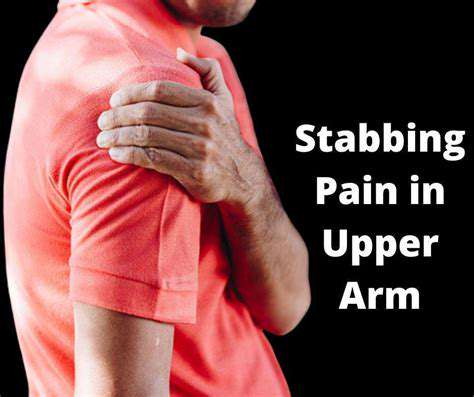What Is Shooting Pain?

Understanding Shooting Pain
Shooting pain is a specific type of discomfort that can feel like a sudden, sharp sensation. This sensation often travels along a nerve path and can vary in intensity and duration. People often describe it as a bolt of electricity or a jolt in the affected area. It can occur anywhere in the body but is most commonly reported in the back, legs, or arms. Understanding the nature of shooting pain is critical for effective treatment and management.
Common Causes of Shooting Pain
There are several potential causes of shooting pain, many of which are related to nerve irritation or injury. Conditions such as sciatica, which involves nerve compression in the lower back, can cause sharp shooting pain that radiates down the leg. Other causes may include herniated discs, shingles, or peripheral neuropathy, which affects nerve signals. Identifying the underlying cause is essential for determining the appropriate treatment. Consulting a healthcare professional can help pinpoint the root issue and aid in recovery.
Symptoms Associated with Shooting Pain
Shooting pain often presents alongside other symptoms, which can provide additional context for diagnosis. Patients might experience tingling, numbness, or a burning sensation in conjunction with the sharp pain. The intensity and frequency of the pain can also fluctuate, further complicating the experience. Some individuals might feel weakness in the affected limbs. Understanding these associated symptoms can be vital for assessing conditions leading to shooting pain.
Effective Remedies and Treatments
Several treatment options are available for managing shooting pain, depending on its cause. Physical therapy often plays a crucial role by strengthening muscles and improving flexibility, thereby alleviating nerve pressure. Medications such as NSAIDs or nerve pain prescriptions may provide temporary relief. In some cases, more invasive treatments like injections or surgery might be necessary to address the root cause. Lifestyle changes, including regular exercise, proper posture, and stress management techniques, can also contribute to pain relief over time.
Common Causes of Shooting Pain
Injury and Trauma
Shooting pain often occurs following an injury or trauma to the body. This can be due to strains, sprains, fractures, or direct impact. The pain signals the brain that there is damage or potential damage to the tissues. Depending on the severity of the injury, the type of shooting pain can vary.
Traumatic injuries can also lead to inflammation around the affected area, which may intensify the pain. For example, a sprained ankle can create a sharp, shooting sensation when putting weight on it. Understanding the injury type is crucial for effective treatment.
In most cases, managing shooting pain from injuries involves rest, ice, compression, and elevation (the RICE method). However, severe injuries might require medical intervention, including imaging or surgery to address the underlying issues.
Nerve Compression or Damage
Nerve-related issues, such as those caused by herniated discs, sciatica, or carpal tunnel syndrome, can lead to intense shooting pain. This pain often radiates along the path of the affected nerve, which can be debilitating. It’s essential to recognize that shooting pain due to nerve problems may also be accompanied by numbness or tingling sensations.
The mechanisms behind nerve compression often involve herniated intervertebral discs or bone spurs pressing against the nerve roots. Identifying these conditions through MRIs or CT scans is key to determining the appropriate treatment, which might include physical therapy, medication, or, in some cases, surgery.
Managing nerve compression pain often requires a multifaceted approach, incorporating physical therapies that promote healing, as well as medications designed to reduce inflammation and relieve pain. Lifestyle changes, like posture adjustments, can also play a significant role in alleviating symptoms.
Medical Conditions
Various medical conditions can result in shooting pain. Conditions such as fibromyalgia, multiple sclerosis, and diabetes can manifest as shooting pains due to nerve damage and widespread pain sensitivity. Identifying and managing these underlying conditions is crucial to alleviating pain symptoms.
For example, fibromyalgia is characterized by widespread musculoskeletal pain, often described as shooting or sharp. The exact cause remains unclear but may involve disturbances in the way pain stimuli are processed by the brain and nervous system. Treatments for fibromyalgia frequently focus on pain management and improving quality of life through a combination of medication, lifestyle changes, and therapeutic approaches.
Diabetes, on the other hand, can lead to diabetic neuropathy, which causes nerve damage and results in shooting pain in the extremities. Effective management of diabetes through medication, diet, and lifestyle can greatly reduce symptoms and improve overall well-being.
Identifying Symptoms Associated with Shooting Pain
Common Symptoms of Shooting Pain
Shooting pain is often described as a sudden and acute sensation that travels along a path, usually following a nerve route. This type of pain can vary in intensity, from mild discomfort to severe agony. It may feel like an electric shock or stabbing sensation, depending on the underlying cause. Understanding these common symptoms can aid in diagnosing and treating the condition more effectively.
Patients may experience shooting pain in localized areas, commonly in the back, neck, arms, or legs. The pain might radiate from one area to another, making it challenging to determine its origin. Alongside shooting pain, individuals might report additional sensations such as tingling, numbness, or a burning feeling.
Another characteristic of shooting pain is its episodic nature. It can occur sporadically or be triggered by specific activities such as movement, bending, or even light touch. This unpredictability can also contribute to distress and anxiety, further complicating the overall experience.
It’s important to note that shooting pain may be accompanied by other symptoms, such as muscle weakness or difficulty in coordination. If these accompanying symptoms are significant, they warrant a more urgent medical evaluation to rule out serious conditions.
Causes of Shooting Pain
Shooting pain can arise from various medical conditions, most commonly related to nerve damage or irritation. Conditions such as sciatica, herniated discs, and neuropathy are frequent culprits. For instance, sciatica occurs when the sciatic nerve is compressed, leading to pain that travels from the lower back down the leg.
Other potential causes include injuries, such as fractures or muscle sprains, which can provoke nerve-related pain. Additionally, certain autoimmune diseases, like multiple sclerosis or rheumatoid arthritis, can also lead to episodes of shooting pain by affecting the nervous system.
In some cases, shooting pain can be triggered by certain lifestyle factors. Poor posture, lack of exercise, and repetitive strain injuries often contribute to nerve irritation and discomfort. Making adjustments to daily habits may help alleviate these symptoms over time.
Moreover, underlying medical conditions such as diabetes may lead to diabetic neuropathy, causing recurrent shooting pain in the extremities. It’s crucial for individuals experiencing persistent shooting pain to consult a healthcare provider for an accurate diagnosis and appropriate treatment options.
Home Remedies and Treatment Options

Understanding Home Remedies for Shooting Pain
When it comes to managing shooting pain, several home remedies can provide significant relief. These remedies often involve natural ingredients that have anti-inflammatory and analgesic properties. For instance, applying a cold compress to the affected area can help reduce swelling and numb sharp pains.
Additionally, many individuals find that heat therapy can be beneficial, particularly for muscle-related pain. A warm compress or heating pad can increase blood flow to the area, promoting healing and easing discomfort.
Herbal remedies, such as turmeric and ginger, are also popular choices for pain management. These herbs possess natural anti-inflammatory properties that can alleviate pain when consumed regularly in teas or supplements.
Lastly, mindfulness practices such as meditation and deep-breathing exercises can help manage the psychological aspects of chronic pain, providing a holistic approach to treatment.
Conventional Treatment Options for Severe Shooting Pain
For more severe cases of shooting pain, seeking professional medical treatment may be necessary. Physicians often prescribe nonsteroidal anti-inflammatory drugs (NSAIDs) to alleviate pain and reduce inflammation. These medications can be highly effective and are available both over-the-counter and through prescription.
In some cases, physical therapy may be recommended to address underlying musculoskeletal issues contributing to shooting pain. A trained therapist can develop a personalized exercise program aimed at strengthening the muscles and improving flexibility.
In instances where pain is caused by nerve-related issues, medications such as anticonvulsants or antidepressants may be prescribed. These drugs can help regulate nerve function and minimize shooting pain sensations.
For chronic conditions that do not respond to conservative treatment, more invasive procedures like corticosteroid injections or nerve blocks may be considered. These options can provide significant and lasting pain relief, enabling a better quality of life for those affected.
When to Seek Medical Attention
Recognizing Severe Symptoms
Shooting pain can manifest in various forms, and recognizing when it becomes severe is crucial. If the pain is sudden and intense, it may warrant immediate medical attention. Severe shooting pain can be a sign of serious conditions such as a herniated disc, sciatica, or nerve damage.
Other accompanying symptoms can help indicate the severity of a situation. If you experience numbness, weakness in your limbs, or difficulty controlling your bladder or bowels, you should seek medical care right away. These symptoms may suggest that the nerves are significantly affected and need urgent treatment.
Additionally, if you find that the shooting pain persists despite over-the-counter pain medications or home remedies, it is advisable to consult a healthcare professional. Persistent pain may indicate an underlying issue that requires diagnosis and treatment.
Finally, it's important to consider the location of the pain. Shooting pain in the chest may signal a heart-related issue, while pain radiating down the arm could indicate a problem with the heart or spine. In such cases, immediate medical intervention is essential.
Understanding Triggers and Risk Factors
Identifying potential triggers for shooting pain can help manage and mitigate symptoms. Many individuals report that certain movements, such as twisting the back or lifting heavy objects, can provoke shooting pain, particularly in the lower back and legs. Recognizing these triggers may aid in avoiding painful flare-ups.
Furthermore, lifestyle choices play a significant role in the occurrence of shooting pain. Factors such as obesity, lack of physical activity, and poor posture can increase the risk of developing conditions that lead to shooting pain. Being mindful of these factors can help prevent the onset of pain.
Age also contributes to the risk of experiencing shooting pain. Conditions like degenerative disc disease or arthritis become more prevalent as people age, heightening the likelihood of shooting pain. Awareness of individual risk factors due to age can lead to proactive management and prevention strategies.
Lastly, genetic predisposition cannot be overlooked. Some individuals may have a family history of spine or nerve-related issues, increasing their likelihood of similar experiences. Understanding your genetic background can inform your approach to managing and addressing shooting pain.